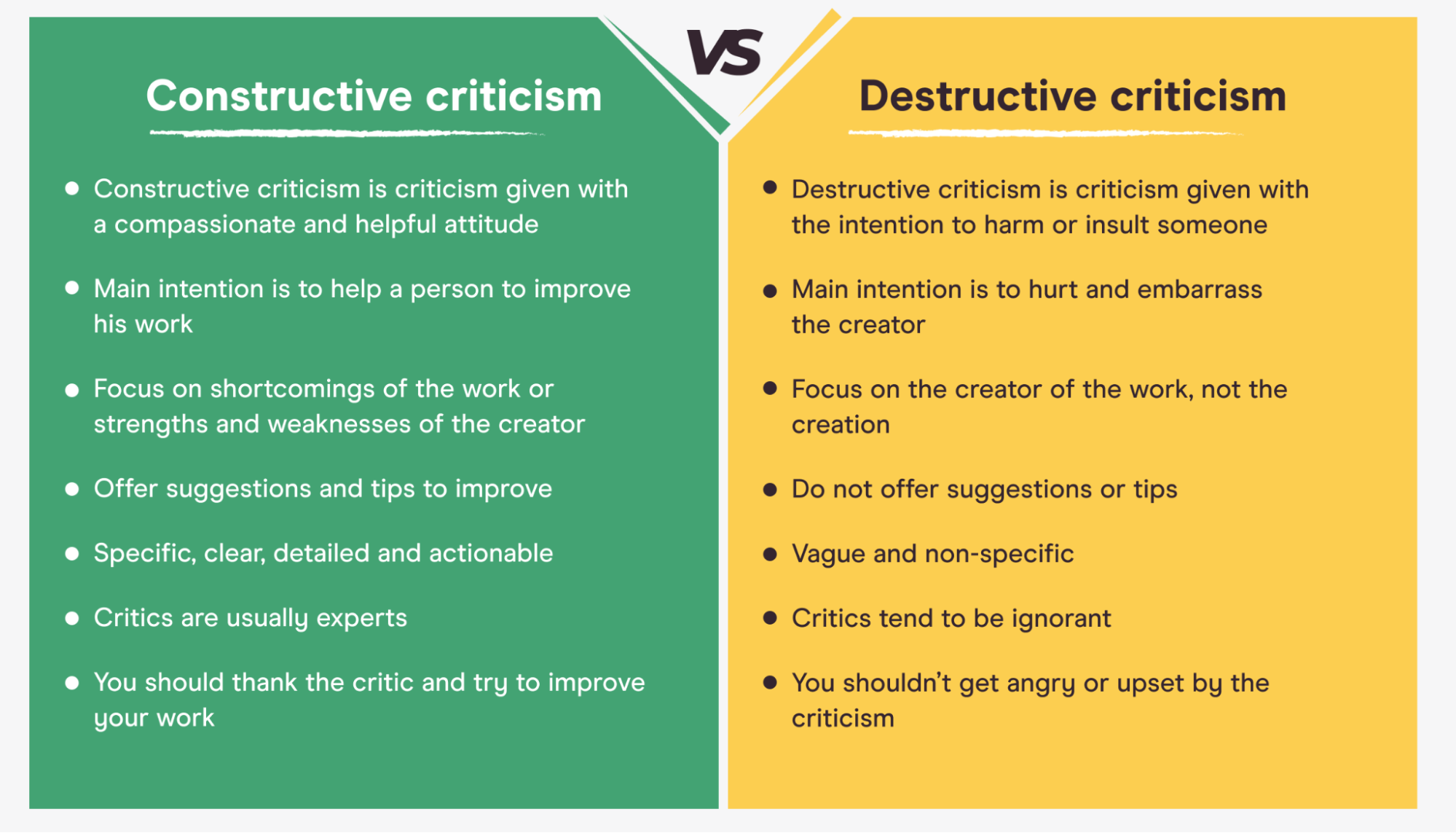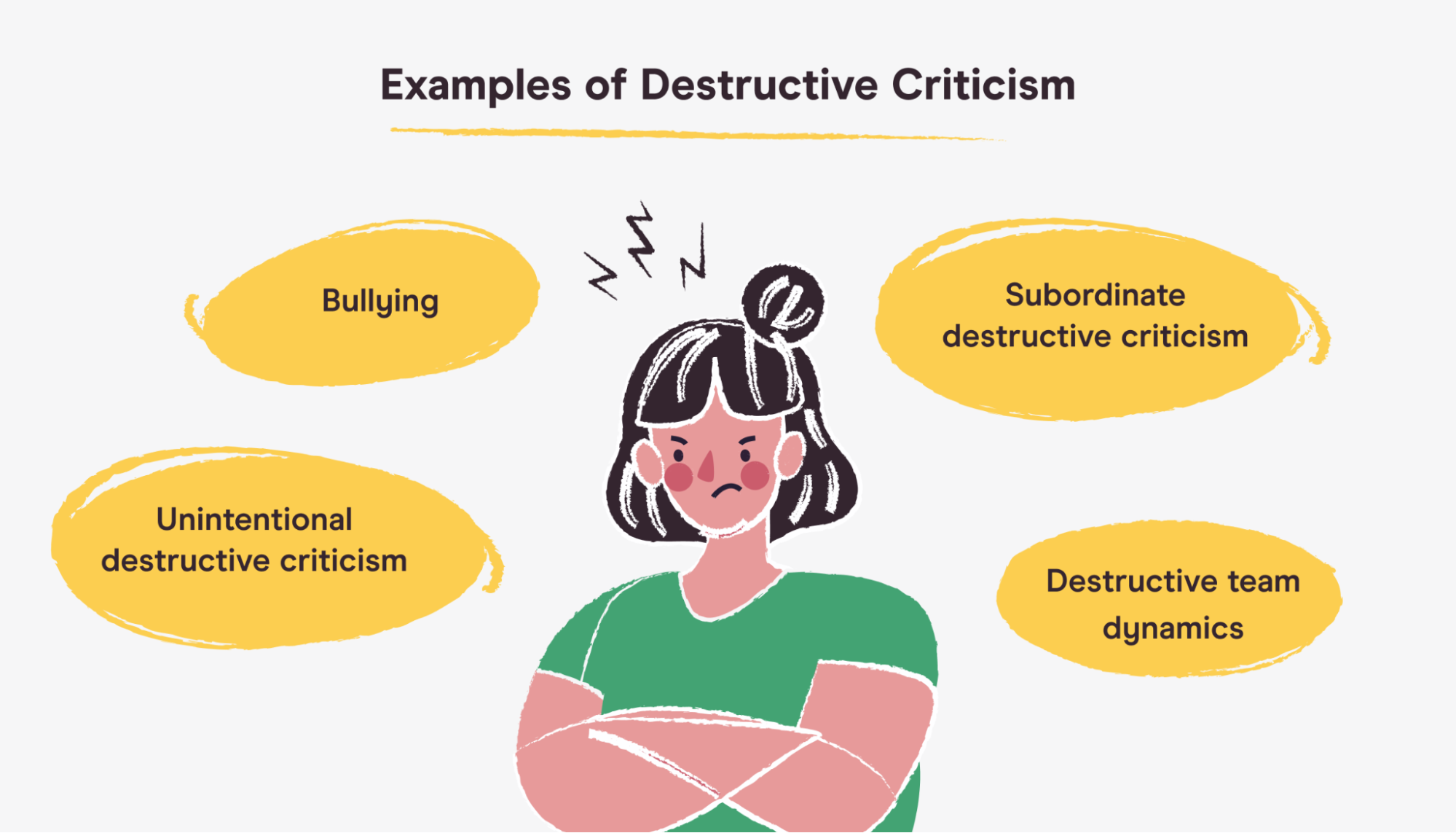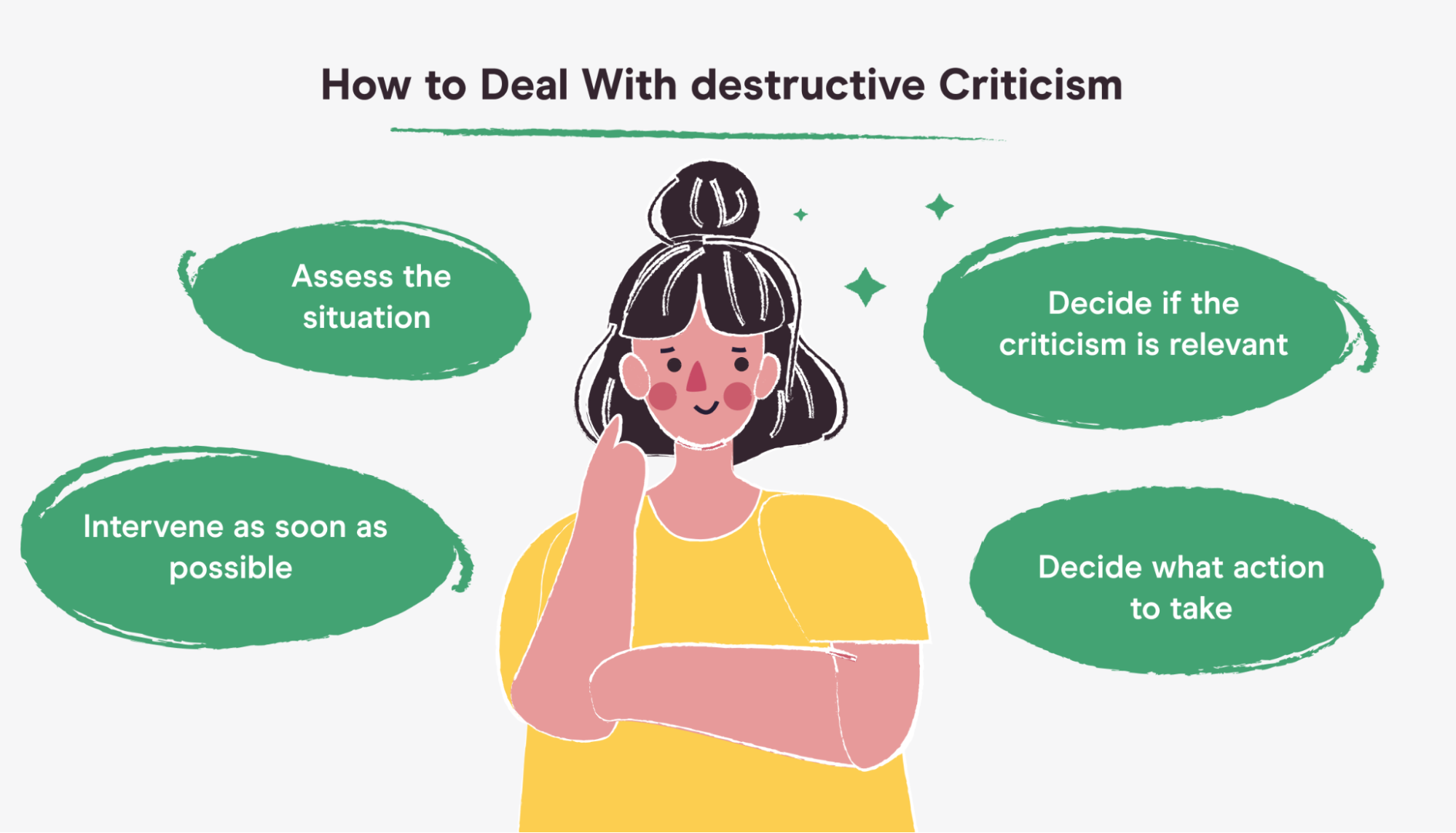Receiving destructive criticism can make your team members feel attacked, judged, and angry. In a professional environment, it can quickly spiral into workplace conflict and bullying.
Destructive criticism can occur at any level of an organization. You might receive it from your boss or a peer or have to deal with it in your team if you’re a team leader.
Destructive criticism can destroy team morale and ruin productivity. As a leader, it’s your responsibility to know how to identify destructive criticism and remove it from your team completely. Then you can get back to being an effective leader and motivating your team.
Let’s take a deep dive into what destructive criticism is, how it affects team dynamics, and how to eliminate it from your team.
What is destructive criticism?
Destructive criticism is negative feedback that harms, undermines, or offends the recipient. It may also impact the person’s reputation and prestige or denigrate their creations or achievements.

Destructive criticism often comes in the form of a personal attack or emotional outburst. It may be based on prejudice, such as sexism or racism, or result from the critic’s own frustrations and insecurities.
For example, if you question an employee’s way of doing things, it might make them feel defensive or inadequate. They might then react by lashing out at you or others around them.
Rather than defending themselves, they attack — and the result is often destructive criticism.
Destructive criticism is usually vague and non-specific. It focuses on people’s personal attributes rather than their actions — for example, calling someone stupid for making a mistake, rather than explaining what they did wrong.
Rather than focusing on the issue, destructive criticism often wanders into unrelated territory, bringing up old grudges and grievances that have nothing to do with the situation at hand.
Anyone can be a destructive critic, and we’ve all been guilty of it at times. In the workplace, a destructive critic might be an overbearing boss, a workplace bully, or a careless co-worker who speaks before thinking.
Constructive vs. destructive criticism
You’ve probably heard of constructive criticism as well as destructive criticism. But what’s the difference between the two?
One of the key differences lies in the intention behind the critique. For example, constructive criticism focuses on problem-solving, while destructive criticism focuses on blame.
Constructive criticism should help the person improve, while destructive criticism hurts or humiliates them.
When you give constructive criticism, you respect the person and their feelings, offering advice and support. You communicate a problem without passing judgment and instead focus on what actions the person can take to improve the situation.
Even then, receiving constructive feedback can still be challenging and lead to feelings of insecurity and frustration.
Some of the main differences between constructive and destructive criticism include:
- Intent: The intention behind what you say
- Delivery: The manner in which you say it (tone of voice, choice of words)
- Focus: Constructive criticism focuses on actions, while destructive criticism focuses on personal attributes
- Specificity: Constructive feedback is specific and actionable; destructive feedback is vague.

What are the effects of destructive criticism?
Research shows that people who receive destructive criticism are more likely to:
- Perceive intended harm
- Blame the person giving them feedback
- Distrust the person giving them feedback
- Feel anger
The evidence also suggests that people who receive destructive criticism are more likely to experience mental health issues such as anxiety and depression.
Within a team, destructive criticism can be a destabilizing force. Here are four of its main consequences.
1. It destroys team coherence
When one team member receives destructive criticism from another, they are more likely to be defensive during their next interaction with that person.
This makes team collaboration more difficult and affects team coherence and the ability of members to work efficiently together. This has a knock-on effect on team productivity and efficiency.
2. It affects employee performance
Even constructive criticism can be received badly, and destructive criticism is even more devastating.
Receiving negative criticism can affect your employees’ self-worth and confidence, hurting their performance at work.
3. It causes conflict
Destructive criticism can quickly escalate into conflict. Since a person receiving destructive criticism feels attacked, they defend themselves with counterattacks.
These often take the form of destructive criticism, too, in that they are personal attacks designed to harm someone rather than resolve a situation.
4. It creates a toxic work environment
Negativity is contagious. When one team member starts becoming disruptive and using destructive criticism, it can affect the whole team and create a toxic work environment.
Examples of destructive criticism
As a leader, it’s essential to recognize destructive criticism within your team so you can nip any problems in the bud before it starts to affect team well-being and performance.
Here are four of the most common forms of destructive criticism that you might come across.

1. Bullying
Bullying can take many forms, so it’s important to know how to spot it as a leader. It might look like an abuse of power — someone in a position of authority using their power over others to coerce or harass them.
It may also be a team leader who clashes with one of their direct reports and, as a result, is aggressive, intimidating, or over-demanding.
Bullying can also take place among and between peers and members of the same team.
2. Unintentional destructive criticism
We can all be guilty of this from time to time. A careless comment that means nothing to you might be deeply offensive to someone else.
And you never know how a negative remark might affect another person. Even a joke can hurt someone’s feelings.
Sometimes the intention behind the criticism is good, but the delivery is bad. In this case, find a way to reframe the criticism in a more positive way.
Focus on problem-solving and inviting the person receiving the feedback to share their perspective, too.
3. Subordinate destructive criticism
Subordinate destructive criticism occurs when a team member refuses to accept the authority of their line manager or another member of the hierarchy.
It often occurs as a result of prejudices such as sexism or racism. White male colleagues are often unaware of the pervasiveness of this type of destructive criticism, so they need to be aware of it.
4. Destructive team dynamics
A disagreement between two team members can quickly spiral into a destructive team dynamic. The team might split into two sides, or the whole team might turn against their leader.
How to respond to destructive criticism as a leader
As a leader, you’re responsible for stamping out destructive criticism within your team. Follow these four steps to defuse tensions and prevent the situation from escalating.

1. Intervene as soon as possible
Destructive criticism can quickly escalate into workplace conflict and become a destabilizing force for your team.
The team leader must be vigilant and aware of what is going on at all times. Step in as soon as you suspect or receive reports that destructive criticism is taking place.
2. Assess the situation
To know which course of action to take, you must understand what kind of destructive criticism you’re dealing with.
Is the intention behind the criticism constructive, but the delivery is bad? Assess whether the criticism is valid and, if so, give it a constructive reframe.
If you’re dealing with a workplace bully, you’ll need a different strategy. But if the person is projecting their own faults onto others or lashing out, it may be because they feel insecure.
Your response to the destructive criticism will depend on the form it takes. Listen to both sides of the story to get a balanced view of the situation.
3. Decide if the criticism is relevant
Once you’ve assessed the situation, you will know whether the criticism is relevant or not.
If the criticism is relevant, but the delivery was poor, your role as a leader is to find a way to relay the message to the recipient by reframing it as constructive criticism.
Discuss the issue with the recipient and give them the chance to share their side of the story. Then, find the most appropriate way to address it.
This may mean incorporating it into their performance review or a training and development program.
4. Decide what action to take
If the criticism is relevant, you’ll need to discuss it with the person involved. Take the emotion out of the situation and be as objective as possible.
If the criticism is not relevant, reassure the concerned team member. Then, talk to the person who gave the destructive criticism to find out their reasons behind it.
There are many reasons people attack others through destructive criticism, so take plenty of time to understand the root causes before taking action.
It may be that the critic is struggling with problems of their own and needs support. On the other hand, if you’re dealing with a bully, you may need to take disciplinary action.
Don’t let destructive criticism destroy your team
Destructive criticism can quickly escalate into something more serious, so leaders must act fast.
Taking swift action can help prevent destructive criticism from creating a negative work environment and impacting team performance. Taking the emotion out of criticism can help you evaluate whether it’s relevant or not.
If you want to develop your people management skills further to deal with destructive criticism more effectively, check out Pareto Labs’ course on How to Manage People.

